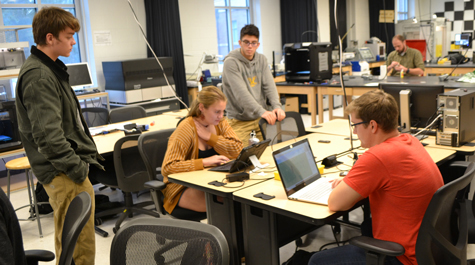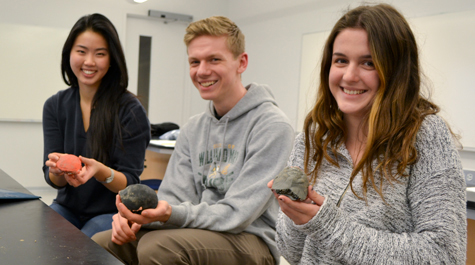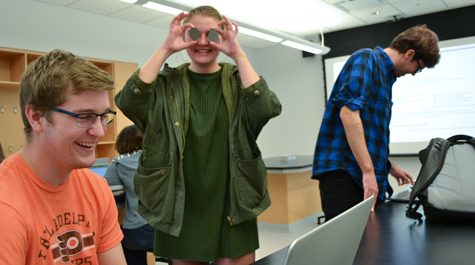Vertebrate Biology in the 21st century involves some time in the makerspace
Election Day, 2018. Bill Storm and Ekaterina Mashanova were looking at computer screens, considering the available options.
They glanced at each other and exchanged wry looks. How to choose among so many snakes?
Storm ’20 and Mashanova ’20 were looking at candidates representing the suborder Serpentes — snakes. Literal snakes. They were especially interested in the scales of the snake and they understood that different snake species have different kinds of scales.
The two, along with teammate Ian Wilenzik ’20, were beginning to pursue a deep understanding of a snake scale. The idea is to probe the form and function of the scale, then manufacture their own scale or set of scales, using the tools and expertise in William & Mary’s makerspace facilities in Swem Library and Small Hall.
The snake team was just one group in Laurie Sanderson’s Vertebrate Biology class. Sanderson wants to introduce her BIOL 456 students to 21st century concepts, skills and techniques.
Sanderson is a professor in William & Mary’s Department of Biology. She has been teaching Vertebrate Biology at the university since 1992. The makerspace-based projects are an enhancement of the lab component of the class. The traditional vertebrate bio lab is based on examination of preserved specimens and bones.
“But now, available biological specimens are more diverse,” she said. “The entire field is more interdisciplinary.”
Traditional dissections still happen
Sanderson’s students still do traditional dissections in lab — for example fish, often specimens obtained from the sampling work at the Virginia Institute of Marine Science. In previous years, there have been field trips, too. But they spend much of the first two-thirds of the semester’s lab work in learning about computer-aided design (CAD), image analysis, 3D scanning and other advanced techniques available to 21st century anatomists.
“The students pick projects as a kind of capstone to the lab,” Sanderson said. “Some element of vertebrate biology that they can work together to design, research and execute.”
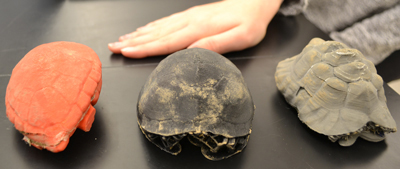 Sanderson's own experiments with CAD and 3D-printed models of fish mouths led to a patent granted to William & Mary in 2016 for a novel filtration device. She introduced advanced-manufacturing concepts to the Vertebrate Biology lab three years ago, when the Bioengineering Lab in the Integrated Science Center acquired two 3D printers. But the expansion of the makerspace environment on campus opens a wider range of possibilities to Sanderson’s students.
Sanderson's own experiments with CAD and 3D-printed models of fish mouths led to a patent granted to William & Mary in 2016 for a novel filtration device. She introduced advanced-manufacturing concepts to the Vertebrate Biology lab three years ago, when the Bioengineering Lab in the Integrated Science Center acquired two 3D printers. But the expansion of the makerspace environment on campus opens a wider range of possibilities to Sanderson’s students.
The Round Table of Makerspace Student Engineers
Each Vertebrate Biology team received the benefit of makerspace guidance from MSEs — Makerspace Student Engineers. “I’m pretty sure I’m empowered to grant knighthoods,” deadpanned Jonathan Frey in introducing MSEs John Garst ’21 and Jacob Brotman-Krass ’22, “so these guys are both Sirs.”
Frey is well into his first year as director of William & Mary’s makerspace environment in Small Hall. Sir John and Sir Jacob are just two of the members of the MSE Round Table that Frey has assembled, a fellowship devoted to offering aid to the questing pilgrims who come seeking arcane lore such as how to reverse-engineer a snake scale.
“The role of the makerspace is to facilitate student-to-student learning, intra-community learning,” Frey explained.
Garst says he is paid for his shifts in the makerspace and is on the books for 10 hours a week.
“I spent probably twice that time here, though,” he said. “Just working on my own projects and other homework. I love being in here.”
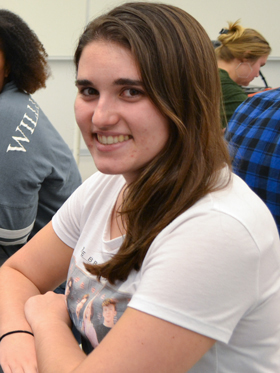 On Election Day, Garst and Brotman-Krass were on the clock, listening to Storm and Mashanova explaining that their team was interested in exploring the variation among snake scale anatomy.
On Election Day, Garst and Brotman-Krass were on the clock, listening to Storm and Mashanova explaining that their team was interested in exploring the variation among snake scale anatomy.
“Snake scales are different,” Storm said. “Ventral and dorsal scales are different. And they’re different among snake species, too”
Another team was working in the Small Hall Makerspace on Election Day. Call them Team Turtle. Their plan was to test the design of three kinds of turtle shells for resistance to being cracked when dropped by predatory birds.
“No turtles will be harmed in the pursuit of this project,” intoned Angie Pak ’20, as she checked out turtle shell scans available online. Her teammate Cameron Staubs ’20 said that the idea was to replicate the shells in a 3D printer and drop them from a drone.
“Do you have any wire?” Staubs asked Garst.
“Wire? We have plenty of wire!,” Garst said, opening one of the cabinets along the makerspace wall to reveal an ample supply of insulated copper in manifold gauges.
“No, I mean like a coat hanger,” Staubs said. She explained that she had found online instructions for building a drone payload-release mechanism that called for plain old hanger wire.
Starting on the internet
Like Staubs’ drone hack, the how-to portion of most of the projects began on the internet. The third member of Team Turtle, Evan Broennimann ’20, explained that they were looking for three-dimensional scans of turtle shells that could be used to create 3D renderings for experimenting.
“We found some we liked, but there was a charge,” Broennimann said. “We needed open source or Creative Commons images.”
By late November, the projects were in advanced stages. The snake-scale team showed off a pair of scales, a product of the 3D printer in the Swem Library makerspace. The renderings of the scales were based on anatomical scans of a Mexican pit viper, Atropoides nummifer.
 One of their scales had a keel; the other was smooth on both sides. They made a computer simulation showing how all scales work together as a lattice network.
One of their scales had a keel; the other was smooth on both sides. They made a computer simulation showing how all scales work together as a lattice network.
“We now know how to make a network of scales — and how to analyze it,” Mashanova said. “A lot of studies view snake scales in the context of movement, but now we can also analyze them in the context of armor.”
The turtle group ended up with three turticular species for their drop test and lined them up for inspection.
“This is the leopard tortoise. This is a box turtle and this is a sea turtle,” Broennimann said. “The idea was to see which shell shape was most resistant to being dropped by a bird.”
He said the team predicted the box turtle shell would be most resistant, as box turtles are more likely than the other two species to be the object of bird predation. “The leopard tortoise is very big,” Broennimann explained. “And the sea turtle is…in the ocean!”
Their observations supported their hypothesis. “You can look at the box turtle shell and you can see it doesn’t have any fractures to the shell, ” Staubs said.
The locomotion specialists
In addition to the snake scale and turtle shell teams there was a third group of individual projects, all involving locomotion. For example, ChiChi Ugochukwu ’20 took her interest in horses into a deep dive into horseshoes.
“My original idea, which was a bit ambitious, was to look at how different styles of horseshoes affect the way in which horses move,” she said. “It’s hard to do a project like that without actual, live horses at my disposal. ”
Ugochukwu was horseless but not recourseless, as she figured out a way to adapt her project to available resources. Many projects were similarly revised. For instance, the turtle team abandoned their drone plan in favor of dropping their printed shells in the high bay laboratory in Small Hall.
Ugochukwu embarked on a study of the anatomy of the equine leg and hoof. She found that there’s an enormous artisanal quality to the shoeing of a horse.
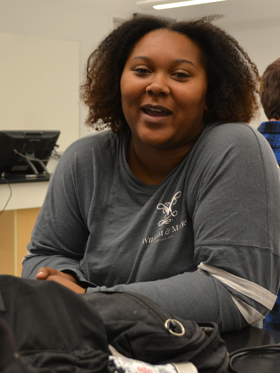 “One of the things I’ve run into is that when a farrier shoes a horse, there’s not any established guidelines,” she said. “It seems more like an art that he's perfected over time: “When you look at different horses each of them will have shoes to fit their need,” she said.
“One of the things I’ve run into is that when a farrier shoes a horse, there’s not any established guidelines,” she said. “It seems more like an art that he's perfected over time: “When you look at different horses each of them will have shoes to fit their need,” she said.
Charnae Holmes ’19 is a biology major and art minor. She combined her two areas of study in an investigation of cartilage, that often-troublesome connective tissue that serves as padding in joints.
“I’m interested in evolution,” she said. “I am studying how cartilage evolved in modern humans, starting with our closest relatives, chimpanzees and then Lucy and on to Homo sapiens.”
Holmes is tracing the development of cartilage in the knee and she is especially interested in the shift from quadrupedalism to bipedalism. She said she is using her studio art background to fill in gaps that science leaves.
“Cartilage doesn't fossilize,” she said. “So I’m using my artistic skills to infer the changes that have occurred.”
As humans grow, they turn most of their cartilage into bone, but some cartilage remains, especially in knees, Holmes said. “A little bit of cartilage in the knee has to support a lot of weight,” she added. “A lot of the problems we have with joints — osteoporosis and things like that — happen because of problems in that area. So, learning about the evolution of cartilage will possibly have some implications in helping people with knee issues.”
Jessica Fleury ’20 would like to improve the state of the art when it comes to prosthetic limbs. The best replacement leg, she said, is one that most closely matches your own gait.
“With a better limb, there would be less need for physical therapy and overall better quality of walking,” she said.
Fleury videotaped people walking, using a camera borrowed from the Reeder Media Center in Swem Library. She recorded their gaits in socks and in sneakers. Then she uploaded the files to her computer and took screen shots, paying close attention to the frames that showed the subject’s heels hitting the floor.
“Then I uploaded the pictures to ImageJ,” she said. Many of the students used ImageJ, a versatile image-processing program developed by the National Institutes of Health.
Fleury used ImageJ to take a set of measurements for each subject: the angles created when the feet hit the floor, stride length and so on. She found that the mechanics of walking has interesting variations.
“Everyone has a different walk,” she said. “Some people hit the floor more flat footed. Some people have a higher elevation when they hit the floor. You’d think some people who are taller would have a longer stride. Usually they do, but that’s not always the case.”















